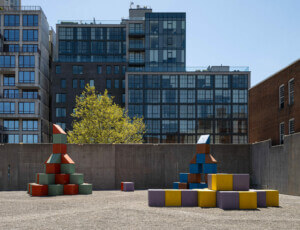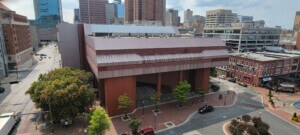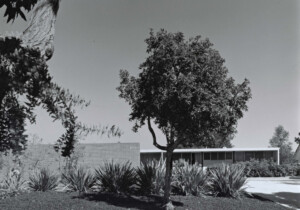What remains of the former Paul Rudolph-designed North American headquarters of pharmaceutical giant Burroughs Wellcome & Company is now being demolished in North Carolina’s Research Triangle Park.
The building, a locally and nationally beloved Brutalist icon dedicated in 1972 and joined by a 1986 annex also designed by Rudolph, was acquired from then-owner GlaxoSmithKline by biotechnology company United Therapeutics in 2012 as part of a campus expansion project. Two years after the sale, United Therapeutics razed portions of the sprawling, S-shaped structure while pledging to eventually restore and reuse the still-standing sections of the building, which had since fallen into an advanced state of neglect and disrepair. United Therapeutics was unable to keep that promise and, as of this writing, the entire structure is in the process of being bulldozed out of existence.
The demolition, while disheartening, does not come as a surprise. In September of last year, a photo-snapping tipster had noticed a flurry of construction activity at the building, which soon led to the revelation that a demolition permit had indeed been issued to United Therapeutics on September 4. Kelvin Dickinson, president and CEO of the Paul Rudolph Heritage Foundation, explained to AN in September that there were initial hopes that it was all just a false alarm and the work being carried out at the building was related to asbestos removal. But as the Foundation soon discovered, it was indeed prep work for a full demolition.
“Burroughs Wellcome is a significant design of architecture that rises to the level of exceptional. There is absolutely nothing else like it and it would be devastating to Paul Rudolph’s canon of built works to lose it,” Liz Waytkus, executive director of modern architecture conservation nonprofit Docomomo US, told AN at the time. Docomo US referred to the latest news as “incredibly frustrating,” and noted that the building was “lost because people thought it was a landmark when in reality it had no protection and sat vacant for years.”
Initial news of the planned demolition in September sparked widespread outrage and frustration. (And the requisite Change.org petition.) Just weeks after the demolition plans for Burroughs Wellcome came to light, AN contributor Kate Wagner reflected on her personal relationship with the building and the continued imperilment of Brutalist landmarks, particularly those designed by Rudolph:
“I write this as a means of processing the impending loss of a building I care deeply about as a historian and as an individual, but also because I believe that the preservation community is facing a hard truth: Their battle is not against one bulldozer-happy company or developer but against an economic system that reduces architecture to an asset that sits upon an even more valuable asset—land. The court of public opinion has no say over the rule of the wallet, and even the success of a decade-long campaign to recuperate Brutalism from the trash heap of history cannot alone save Burroughs Wellcome from the wrecking ball. Time repeats itself—I once sat in a chair in my room on a laptop typing up letters and school assignments devoted to saving the Goshen Building; ten years later, I sit in my office and type this essay about mourning another building by the same architect. Both times, despite it all, grief is mixed with hope.”
With news that the demolition of the Burroughs Welcome building—renamed 1988 in tribute to Nobel Prize-winning Burroughs Wellcome scientists Gertrude Elion and George Hitchings— is underway, United Therapeutics spokesperson Dewey Steadman explained to Richard Stradling of the Raleigh News & Observer that the company had indeed looked into reusing the building but ultimately concluded it was “unsafe, not environmentally sound, and functionally obsolete.”
“What is so special about this site is the groundbreaking research and life-saving medicines that were developed here,” Steadman told the News & Observer. “That is a legacy that United Therapeutics looks forward to carrying on in the years to come.”
The groundbreaking research referred to by Steadman was of azidothymidine (AZT), an antiretroviral medication first developed in the 1960s to treat cancer and later more successfully used in the treatment of HIV/AIDS. Because of the facility’s status as the birthplace of AZT, it served as the backdrop for numerous demonstrations staged by ACT UP over the drug’s exorbitant cost during the 1980s. The Burroughs Wellcome building also boasted significant 1980s pop-culture cred as a prominent filming location for the 1983 sci-fi thriller Brainstorm, which starred Christopher Walken, Louise Fletcher, and Natalie Wood in her final film role.
Steadman told the News & Observer that whatever new future building is erected on the site will also be named in honor of Elion and Hitchings and that the interior will feature a so-called “Paul Rudolph Foyer.” There’s also an effort to salvage as much of the structure as possible.
Wrote the Paul Rudolph Heritage Foundation in a January 18 Twitter thread reacting to the news:
“Sadly, the Burroughs Wellcome demo is an update we wish we didn’t have to make. There are others threatened too (see the Govt Center in Boston) where people ‘claim’ Rudolph was not really involved as cover to allow demolition and/or redevelopment. The lesson of all of this is ‘if you like it — take a photo of it, talk about it, draw a sketch of it, take your students or family to see it, walk around and thru it, cause without you it will be gone.’ And if you see something at a Rudolph site — please let us know. We learned about BW from a local fan who sent us pics out of concern. Your voice and vigilance matters. Maybe not today but tomorrow it could save the next project.”











